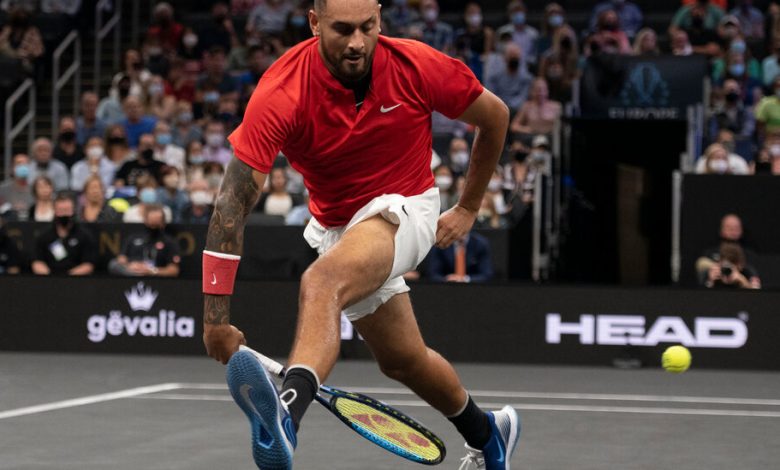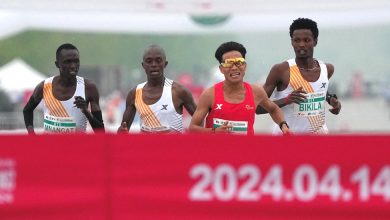The Tennis Player’s Dilemma: Play It Safe, or Go For Broke?

Tennis players must constantly make tactical decisions about the best way to win a point. It starts with where to put the serve and how hard to hit it, but once the rally starts the question often becomes whether a player should aim for the lines or hit the ball hard to a safer target with more margin for error.
Choosing right is especially vital in a close match when the stakes are high and the opponent is one of the world’s best players, as they will be at the Laver Cup.
The best tactical approach, players and analysts say, requires a mix of both styles.
“It depends on your strengths, your opponent and the situation in the match,” said Patrick McEnroe, Team World’s vice captain. “That’s what makes it so interesting at this event. Every match is against top players, and you have to weigh all three of those things.”
That’s not so simple. Anyone who watched Carlos Alcaraz in the United States Open knows the sport’s new king (who isn’t at the Laver Cup) will run, run, run in endless rallies but also happily goes for broke anytime and from any place on the court; superb players like Team Europe’s Caspar Ruud and Frances Tiafoe of Team World tried matching him for hours and fell short.
“When Tiafoe got a midcourt ball, he probably thought, ‘I have to hit it closer to the line’ than he would against, say, Fabio Fognini,” who is ranked at No. 55, McEnroe said.
Elite players like Roger Federer and Andy Murray in their prime might have hit defensive backhands against a go-for-broke shot — not weak but defensive, with the intent to neutralize — but McEnroe said the U.S. Open showdown between Alcaraz and Jannik Sinner featured two players “hitting hugely aggressive shots and going toe-to-toe, point after point.”
Often, however, big moments in big matches against top opponents prompts an adjustment. Tennis is a confidence game, said Jimmy Arias, a Tennis Channel analyst. Players like Novak Djokovic or Serena Williams in her prime would nail the lines in big moments simply because they believed they’d win and therefore played more relaxed.
For contrast, he points to his 1983 U.S. Open quarterfinal victory over Yannick Noah, who had won the French Open that year. When Noah, down 5-6 in the fifth set, double faulted at 15-30 and missed his first serve on match point, Arias, who hadn’t broken serve in over two sets, saw an opportunity.
“I know 100 percent he’s going to do a safe serve, and I’ll be able to run around and hit a forehand,” recalled Arias, who was 19 at the time. “In a normal match, I’d have been confident and would’ve gone for a winner. But I’d never been to the semis of a major, and I wanted it so badly.”
So Arias decided to play it safe and hit hard up the middle, granting himself a margin for error. “I was so anxious I hit the ball way out in front,” he said. Had he aimed for the sidelines, the shot would have landed way out, but because he played it safe, the misfire “ended up being an angle winner.”
The right approach is often determined by the player’s outlook. “Young players sometimes do too much on points when they’re playing the best guys, who always have a mental advantage. If you are playing [Rafael] Nadal or Djokovic or Federer you tend to think, ‘I have to do something extra,” said Bjorn Borg, captain of Team Europe.
Borg advocates for starting tougher matches by hitting big to safer spots “to get a feel for the match” before becoming more ambitious; if a player starts missing the lines midmatch, they should retreat to safer shots for a few games to regain their rhythm and feel.
McEnroe said that a player like Diego Schwartzman of Team World knows he “must play out of his comfort zone or he won’t have a chance,” but that aiming for perfection straight away means “you can hit yourself out of the match early, so you don’t want to give your opponent too much respect early on.”
But, Arias said, it gets tougher mentally to go for the lines as sets continue, especially in a tournament like the Laver Cup, “when it feels like all the opponents are better than you,” he said. “There’s extra tension at 5-5 or 6-6, so you may not come up with the shot.”
Playing Andre Agassi late in his career, Arias reached 4-4, but Agassi was playing every point safe while Arias was going for broke and realized he had no chance: “I couldn’t do it forever.” Arias lost the set and the match.
Ruud said that the nicks and dings of life on the tennis tour were also a factor. “I try to play my game against top players,” but added, “If I’m hurting I’ll take more risks, while if I’m feeling strong I’ll try wearing my opponent out.”
A fitter and quicker player can be more patient and try to force errors. The first of Alcaraz’s five-set Open wins came over Marin Cilic, who is fit but 14 years older and without Alcaraz’s blazing speed. “I have no doubt Cilic was trying to play more aggressively because of that,” McEnroe said.
Nick Kyrgios, who played in the first four Laver Cups, said that he preferred going for broke, especially at the biggest moments.
“I like low-percentage tennis,” said Kyrgios, who landed two risky cross-court short-angle forehand winners down 0-30 at 4-4 in the fourth set of his second-round win at this year’s U.S. Open. “My strength on the tennis court is my unpredictability. Why wouldn’t I just go for it?”
But Arias noted that in the next round, against the young, big-hitting J.J. Wolf, Kyrgios switched gears, hitting safer shots and letting Wolf make mistakes. “You could see the light turn on in Nick’s head during the match,” he said.
Shifting gears is easier said than done, of course, especially in the middle of a match. “It can make sense to switch,” McEnroe said, “but against the top-level players all of those decisions become magnified.”




